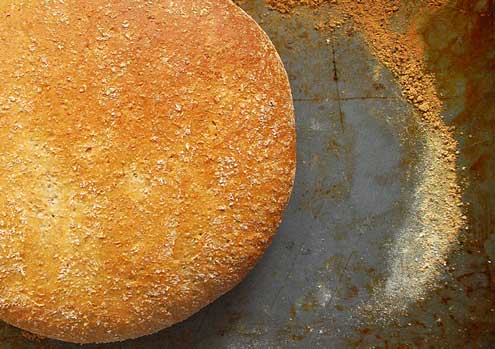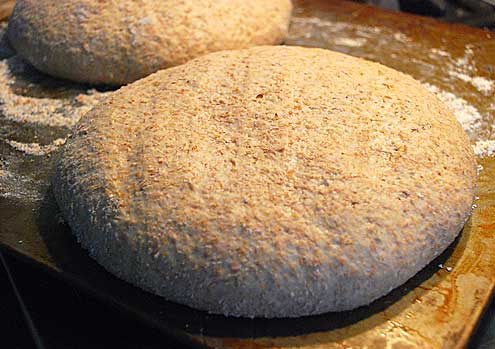Now it seems it’s no longer middle class enough to simply bake your own bread. To be a fully paid-up member of the bourgeoisie takes more time. We have to allow our dough to slowly ferment overnight to encourage friendly bacteria which will protect our delicate constitutions from bloated, irritable bowels and leaky gut-type conditions. On a less intestinal note, it is also meant to result in a more nutritious and tasty loaf and so had to be worth a punt.

Preparation time: 15 – 20 minutes plus 12-18 hours fermenting
Cooking time: 25-35 minutes
Skill level: Easy
Ingredients
For the overnight sponge
- dried yeast – 3g
- water – 130g (at about 20°C)
- stoneground wholemeal flour – 150g
For the final dough
- overnight sponge (from above)
- wholemeal or a mix of white and wholemeal flour – 450g
- salt – 5g
- water – 270g (warm to the hand, 30-35°C)
- butter or olive oil – 15g (optional, but makes the bread a bit softer)
Start the night before it is needed by making the ‘overnight sponge’. Add the flour, yeast and water to a large bowl, mix to a smooth paste, cover with cling film and put aside at room temperature for 12 to 18 hours. After this time the sponge should have expanded to three times its original size.
The next day add all the remaining ingredients to the overnight sponge and mix together.
Turn out onto a floured surface and knead for 5 minutes until the dough is smooth and stretchy. Cover and leave to rise for an hour.

Divide the dough in half and form into 2 round loaves. Roll in wholemeal flour and place on a large floured baking tray – leaving plenty of room for them to expand.*
Place in a large plastic bag or Tower Hamlets recycling bag (making sure it doesn’t touch the dough) and leave in a warmish place for 1-2 hours until doubled in size.

Caution: Do not put plastic bags on your head – it can be dangerous.
Place in a pre-heated oven (220C/gas mark 7) and cook until the bread is nicely browned and hollow sounding when tapped (about 25-30 minutes)
Leave to cool on a wire rack.
*If you want to make rolls instead, divide into 12 and cook for 10-15 minutes.
Verdict: Is it worth the extra effort? Yes it is as this definitely produces a lighter, chewier, tastier loaf. In fact the extra effort involved is so negligible it shouldn’t put anyone off from trying this technique.
Drink: Some traditionally fermented liquid.
Entertainment: With 18 hours to kill there is plenty of time for televisual entertainment such as ’15 Storeys High’, ‘Outlaws’ and another disappointing episode of ‘Doctor Who’.


Ha ha! I like your writing, you are funny. There does seem to be rather a trend for those leaky-type gut conditions doesn’t there? Thankfully, I don’t have one and so am free to enjoy the wonders of bread. It’s a lovely looking loaf.
Hi Helen.
I made another batch of this bread at the weekend, but recklessly left the house for several hours while it was supposedly ‘rising’.
Turns out it was ‘spreading’.
The resulting loaf was as thin as a Rizla and the diameter of a dustbin lid.
Nice though … bit like a Ryvita.
R